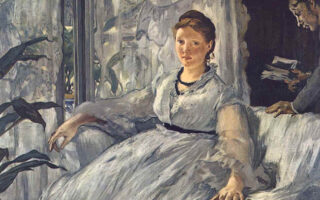Around and About Paris: Héloise and Abélard
833
Thirza Vallois’s internationally acclaimed
Around and About Paris series is filled with stories of romance,
passion, and love, from the purest to the most scandalous. From the
90-year-old philosopher Fénélon to the 17-year-old Mother Superior of
the Abbey of Montmartre, from Madame de Pompadour to Edith Piaf… Even
Benjamin Franklin was caught in the game of love and was swept off his
feet by the 60-year-old widow of the great Philosopher Helvétius. For
more information and Thirza’s appearance schedule, please visit her
website at http://www.wfi.fr/vallois/ The
following excerpt is taken from Around and About Paris, Volume 1 and
tells the story of France’s most famous lovers, Héloise and Pierre
Abélard. It is part of a romantic walk author Thirza Vallois has
designed in the side streets round Notre Dame. If you can’t make it to
Paris on Valentine’s Day, relax in your armchair and let your
imagination carry you off… “Turn
left into rue Chanoinesse, a serene and peaceful artery, of which
tourists who flock to the cathedral are, mercifully, unaware. Notice in
particular the two houses on the opposite sides of rue des Chantres –
the countrified house at no. 10 with its picturesque shutters and its
top terrace bursting with green vegetation, and the elegant
17th-century mansion with its beautiful wrought-iron decoration. In the
year 1118, the house that stood on the site of the present no. 10 was
occupied by the canon Fulbert: it was a substantial property with
grounds extending along rue des Chantres, probably as far as the site
of 9 quai aux Fleurs along the river. In that fateful year Fulbert
welcomed into his home both his niece, the 17 year-old Héloïse, who was
related to the great Montmorency family, and Pierre Abélard, then 39
years old. It made sense to the canon that his niece should benefit
from the remarkable knowledge and intelligence of this great master of
rhetoric and dialectics, a disciple of Guillaume de Champeaux, and he
therefore asked Abélard to take charge of her education. He omitted to
take into consideration the forces of nature and the fact that Pierre
Abélard had great charisma (which is why throngs of students followed
him to the Left Bank when he settled there). Pierre
was handsome, brilliant, a poet and an accomplished musician. Master
and pupil ended up in each other’s arms, and before long Hélïse was
pregnant and had to be sent to Brittany to have her baby out of
society’s sight. Fulbert meanwhile awaited his opportunity for
vengeance and, when it came, took Abélard unawares and castrated him.
From then on the love between Abélard and Héloïse became as mythical as
that of Tristan and Isolde, an impossible love that was neither
accepted by the establlishment nor fulfilled and therefore could not
even become an act of defiance. Salvation could lie only in death,
except that, in this case, it was a true story. It so happens that they
both died at the age of 63. Just before Héloïse died, she secretly
recovered the body of Abélard and brought it over to the oratory of
Parclet, which she had founded near Nogent-sur-Seine. On her death,
their bodies were laid in the same coffin and remained so for two and a
half centuries, until 1497, when the oratory of Parclet was threatened
with ruin and the coffin was moved to the church of Petit-Moustiers.
Here a prudish nun separated their remains and laid them in two
separate tombs. The Revolutionary authorities united them again in a
single coffin, in 1792, but fixed a lead partition between them, then
sent them back to Nogent-sur-Seine. Meanwhile
Alexandre Lenoir was filling his newly created museum of French
monuments with whatever he could rescue from the clutches of the
Revolution and transferred the famous lovers to it. In 1817 they were
deposited in the church of Saint-Germain-des-Prés, though not for long.
The new cemetery Le Père Lachaise, on the eastern edge of Paris, was
trying to enhance its prestige among the bourgeoisie of western Paris,
as yet reluctant to lay its dead in those remote plebeian parts, and
was looking for illustrious tenants. The monument was therefore
transferred to Le Père Lachaise the same year. At last, the lovers
found a permanent abode in what has since become the 7th division of
the cemetery, in the unlikely company of Paris’s 19th-century
bourgeoisie. In 1844 two medallions representing the two lovers were
fixed to the door at no. 9 quai aux Fleurs.” Have you walked this part
of Paris? What stands out in your mind? Visit our Sightseeing Discussion Board. Thirza
Vallois is the author of Around and About Paris, Vol. 1, 2, and 3.Her
video, “Three Perfect Days in Paris,” aired on all United Airlines
international flights throughout September 1998 and on scores of
television channels throughout the year. She is an agrégée of the
Sorbonne (the most prestigious of French university degrees) and made
excellent use of her academic background during her eight years of
research dedicated to Paris, which has culminated in her books. For
more information and Thirza’s appearance schedule, please visit her
website at http://www.wfi.fr/vallois/ Copyright (c) 2000 Paris New Media, L.L.C.
- SUBSCRIBE
- ALREADY SUBSCRIBED?
BECOME A BONJOUR PARIS MEMBER
Gain full access to our collection of over 5,000 articles and bring the City of Light into your life. Just 60 USD per year.
Find out why you should become a member here.
Sign in
Fill in your credentials below.
Thirza Vallois’s internationally acclaimed
Around and About Paris series is filled with stories of romance,
passion, and love, from the purest to the most scandalous. From the
90-year-old philosopher Fénélon to the 17-year-old Mother Superior of
the Abbey of Montmartre, from Madame de Pompadour to Edith Piaf… Even
Benjamin Franklin was caught in the game of love and was swept off his
feet by the 60-year-old widow of the great Philosopher Helvétius. For
more information and Thirza’s appearance schedule, please visit her
website at http://www.wfi.fr/vallois/
Around and About Paris series is filled with stories of romance,
passion, and love, from the purest to the most scandalous. From the
90-year-old philosopher Fénélon to the 17-year-old Mother Superior of
the Abbey of Montmartre, from Madame de Pompadour to Edith Piaf… Even
Benjamin Franklin was caught in the game of love and was swept off his
feet by the 60-year-old widow of the great Philosopher Helvétius. For
more information and Thirza’s appearance schedule, please visit her
website at http://www.wfi.fr/vallois/
The
following excerpt is taken from Around and About Paris, Volume 1 and
tells the story of France’s most famous lovers, Héloise and Pierre
Abélard. It is part of a romantic walk author Thirza Vallois has
designed in the side streets round Notre Dame. If you can’t make it to
Paris on Valentine’s Day, relax in your armchair and let your
imagination carry you off…
following excerpt is taken from Around and About Paris, Volume 1 and
tells the story of France’s most famous lovers, Héloise and Pierre
Abélard. It is part of a romantic walk author Thirza Vallois has
designed in the side streets round Notre Dame. If you can’t make it to
Paris on Valentine’s Day, relax in your armchair and let your
imagination carry you off…
“Turn
left into rue Chanoinesse, a serene and peaceful artery, of which
tourists who flock to the cathedral are, mercifully, unaware. Notice in
particular the two houses on the opposite sides of rue des Chantres –
the countrified house at no. 10 with its picturesque shutters and its
top terrace bursting with green vegetation, and the elegant
17th-century mansion with its beautiful wrought-iron decoration. In the
year 1118, the house that stood on the site of the present no. 10 was
occupied by the canon Fulbert: it was a substantial property with
grounds extending along rue des Chantres, probably as far as the site
of 9 quai aux Fleurs along the river. In that fateful year Fulbert
welcomed into his home both his niece, the 17 year-old Héloïse, who was
related to the great Montmorency family, and Pierre Abélard, then 39
years old. It made sense to the canon that his niece should benefit
from the remarkable knowledge and intelligence of this great master of
rhetoric and dialectics, a disciple of Guillaume de Champeaux, and he
therefore asked Abélard to take charge of her education. He omitted to
take into consideration the forces of nature and the fact that Pierre
Abélard had great charisma (which is why throngs of students followed
him to the Left Bank when he settled there).
left into rue Chanoinesse, a serene and peaceful artery, of which
tourists who flock to the cathedral are, mercifully, unaware. Notice in
particular the two houses on the opposite sides of rue des Chantres –
the countrified house at no. 10 with its picturesque shutters and its
top terrace bursting with green vegetation, and the elegant
17th-century mansion with its beautiful wrought-iron decoration. In the
year 1118, the house that stood on the site of the present no. 10 was
occupied by the canon Fulbert: it was a substantial property with
grounds extending along rue des Chantres, probably as far as the site
of 9 quai aux Fleurs along the river. In that fateful year Fulbert
welcomed into his home both his niece, the 17 year-old Héloïse, who was
related to the great Montmorency family, and Pierre Abélard, then 39
years old. It made sense to the canon that his niece should benefit
from the remarkable knowledge and intelligence of this great master of
rhetoric and dialectics, a disciple of Guillaume de Champeaux, and he
therefore asked Abélard to take charge of her education. He omitted to
take into consideration the forces of nature and the fact that Pierre
Abélard had great charisma (which is why throngs of students followed
him to the Left Bank when he settled there).
Pierre
was handsome, brilliant, a poet and an accomplished musician. Master
and pupil ended up in each other’s arms, and before long Hélïse was
pregnant and had to be sent to Brittany to have her baby out of
society’s sight. Fulbert meanwhile awaited his opportunity for
vengeance and, when it came, took Abélard unawares and castrated him.
From then on the love between Abélard and Héloïse became as mythical as
that of Tristan and Isolde, an impossible love that was neither
accepted by the establlishment nor fulfilled and therefore could not
even become an act of defiance. Salvation could lie only in death,
except that, in this case, it was a true story. It so happens that they
both died at the age of 63. Just before Héloïse died, she secretly
recovered the body of Abélard and brought it over to the oratory of
Parclet, which she had founded near Nogent-sur-Seine. On her death,
their bodies were laid in the same coffin and remained so for two and a
half centuries, until 1497, when the oratory of Parclet was threatened
with ruin and the coffin was moved to the church of Petit-Moustiers.
Here a prudish nun separated their remains and laid them in two
separate tombs. The Revolutionary authorities united them again in a
single coffin, in 1792, but fixed a lead partition between them, then
sent them back to Nogent-sur-Seine.
was handsome, brilliant, a poet and an accomplished musician. Master
and pupil ended up in each other’s arms, and before long Hélïse was
pregnant and had to be sent to Brittany to have her baby out of
society’s sight. Fulbert meanwhile awaited his opportunity for
vengeance and, when it came, took Abélard unawares and castrated him.
From then on the love between Abélard and Héloïse became as mythical as
that of Tristan and Isolde, an impossible love that was neither
accepted by the establlishment nor fulfilled and therefore could not
even become an act of defiance. Salvation could lie only in death,
except that, in this case, it was a true story. It so happens that they
both died at the age of 63. Just before Héloïse died, she secretly
recovered the body of Abélard and brought it over to the oratory of
Parclet, which she had founded near Nogent-sur-Seine. On her death,
their bodies were laid in the same coffin and remained so for two and a
half centuries, until 1497, when the oratory of Parclet was threatened
with ruin and the coffin was moved to the church of Petit-Moustiers.
Here a prudish nun separated their remains and laid them in two
separate tombs. The Revolutionary authorities united them again in a
single coffin, in 1792, but fixed a lead partition between them, then
sent them back to Nogent-sur-Seine.
Meanwhile
Alexandre Lenoir was filling his newly created museum of French
monuments with whatever he could rescue from the clutches of the
Revolution and transferred the famous lovers to it. In 1817 they were
deposited in the church of Saint-Germain-des-Prés, though not for long.
The new cemetery Le Père Lachaise, on the eastern edge of Paris, was
trying to enhance its prestige among the bourgeoisie of western Paris,
as yet reluctant to lay its dead in those remote plebeian parts, and
was looking for illustrious tenants. The monument was therefore
transferred to Le Père Lachaise the same year. At last, the lovers
found a permanent abode in what has since become the 7th division of
the cemetery, in the unlikely company of Paris’s 19th-century
bourgeoisie. In 1844 two medallions representing the two lovers were
fixed to the door at no. 9 quai aux Fleurs.” Have you walked this part
of Paris? What stands out in your mind? Visit our Sightseeing Discussion Board.
Alexandre Lenoir was filling his newly created museum of French
monuments with whatever he could rescue from the clutches of the
Revolution and transferred the famous lovers to it. In 1817 they were
deposited in the church of Saint-Germain-des-Prés, though not for long.
The new cemetery Le Père Lachaise, on the eastern edge of Paris, was
trying to enhance its prestige among the bourgeoisie of western Paris,
as yet reluctant to lay its dead in those remote plebeian parts, and
was looking for illustrious tenants. The monument was therefore
transferred to Le Père Lachaise the same year. At last, the lovers
found a permanent abode in what has since become the 7th division of
the cemetery, in the unlikely company of Paris’s 19th-century
bourgeoisie. In 1844 two medallions representing the two lovers were
fixed to the door at no. 9 quai aux Fleurs.” Have you walked this part
of Paris? What stands out in your mind? Visit our Sightseeing Discussion Board.
Thirza
Vallois is the author of Around and About Paris, Vol. 1, 2, and 3.Her
video, “Three Perfect Days in Paris,” aired on all United Airlines
international flights throughout September 1998 and on scores of
television channels throughout the year. She is an agrégée of the
Sorbonne (the most prestigious of French university degrees) and made
excellent use of her academic background during her eight years of
research dedicated to Paris, which has culminated in her books. For
more information and Thirza’s appearance schedule, please visit her
website at http://www.wfi.fr/vallois/
Vallois is the author of Around and About Paris, Vol. 1, 2, and 3.Her
video, “Three Perfect Days in Paris,” aired on all United Airlines
international flights throughout September 1998 and on scores of
television channels throughout the year. She is an agrégée of the
Sorbonne (the most prestigious of French university degrees) and made
excellent use of her academic background during her eight years of
research dedicated to Paris, which has culminated in her books. For
more information and Thirza’s appearance schedule, please visit her
website at http://www.wfi.fr/vallois/
Copyright (c) 2000 Paris New Media, L.L.C.


